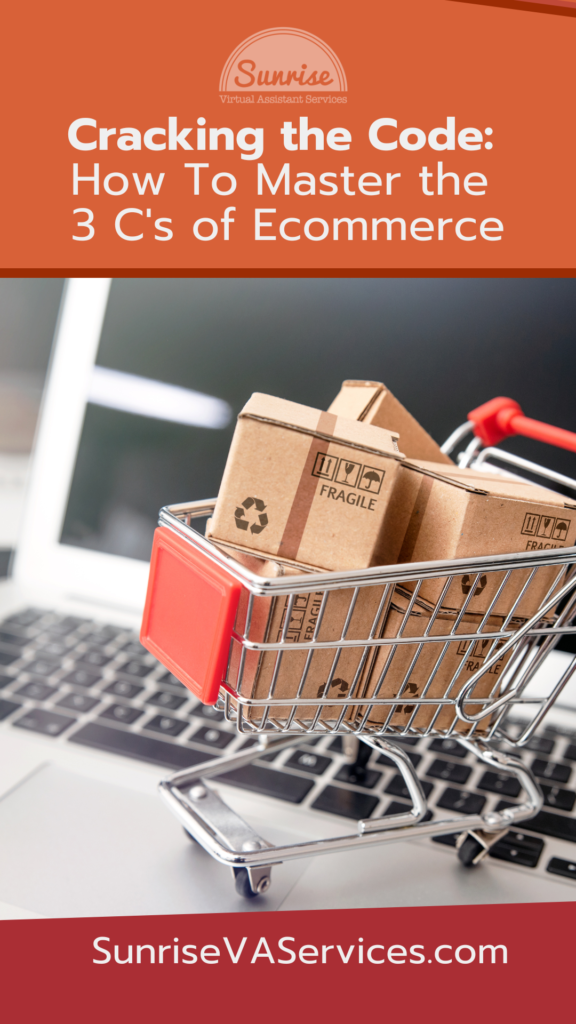E-commerce has become an integral part of our daily lives, making it a lucrative industry for businesses of all sizes. However, to stand out in the highly competitive world of e-commerce (and business in general), one must master the 3 C’s of E-commerce – content, community, and commerce.
But what exactly do these phrases mean, and how can the average small business owner utilize them to their advantage?
In this guide, we’ll dive deep into the 3 C’s of E-commerce and provide actionable tips on using them to elevate your e-commerce game.
What are the 3 C’s of E-commerce?
1. Content
In the context of e-commerce, content refers to the information and experiences directed toward an end-user or audience.
Basically, it’s advertising. Advertising content can take various forms—blog posts, videos, social media updates, ebooks, and many more.
Having great content is essential, but a well-crafted content strategy is the real key to attracting, engaging, and retaining your target audience. Once your target audience becomes loyal followers, you will see a return on investment.
Let’s say you run an e-commerce business selling organic skincare products. Your target audience is health-conscious consumers who value natural, chemical-free products. To engage this audience, you could create a blog post series discussing the harmful effects of chemicals commonly found in skincare products, highlighting the benefits of organic ingredients.
You could also share success stories or testimonials from customers who have benefited from your organic products or offer DIY skincare recipes using ingredients in your products.
The type of content you decide to use to promote your brand can be entirely up to you; as long as it’s relevant to the kind of people you want to advertise to, great content still converts.
Why? By delivering valuable, relevant content, you not only educate your audience but also build trust and credibility for your brand. Over time, this kind of content can influence purchasing decisions, turning potential customers into loyal ones.
2. Community
Developing a community in the context of e-commerce refers to fostering an online environment where your customers feel a sense of belonging and connection to your brand and its values.
This is more than just having a robust customer base; it’s about creating a space where customers can interact, share their experiences, and feel part of a larger picture.
Building a genuine community around your brand and products comes with several benefits. It can increase customer loyalty, as customers who feel a sense of community are likely to stick around. They’ll feel a connection not just to your products but to your brand as a whole, and they’ll become advocates, spreading the word about your brand to their networks.
For example, in the context of our organic skincare business, you could create an online forum or social media group dedicated to discussions about organic skincare. Here, members can ask questions, share their favorite products (which would, of course, include yours), and chat about the benefits of organic skincare. Regular events, such as live Q&A sessions with skincare experts, can further foster a sense of community.
Creating an engaging, inclusive community can lead to stronger customer relationships, valuable user-generated content, improved customer retention, and, ultimately, increased sales.
A strong community also gives you a wealth of insights from your customers, which can be invaluable in guiding your future business strategies. You will gain a better understanding of the types of products your customers already want, with an eager audience ready to buy.
3. Commerce
Commerce, the third ‘C’ of e-commerce, refers to your website’s actual buying and selling process—your offers, deals, revenue-generating streams, and overall user experience when making a purchase.
A well-structured commerce strategy can be the deciding factor that turns a passive visitor into a new customer.
For example, as an owner of an organic skincare e-commerce business, your commerce strategies should, ideally, include:
- Offering a variety of products that cater to different skincare needs.
- Providing competitive pricing along with discounts and deals.
- Ensuring a seamless, user-friendly checkout process.
You could also introduce revenue-generating streams such as a subscription service for regular deliveries of your products, adding convenience for your customers while ensuring a steady flow of income for your business.
The user experience is an essential aspect of your commerce strategy. This encompasses everything from the layout of your website and product descriptions to the ease of navigation and the simplicity of the checkout process.
It’s just the truth; a good customer experience will make shopping enjoyable and stress-free for your target customers, encouraging them to come back for more. In contrast, poor experience does the opposite.
Think about the last time you tried buying something online and dealt with a buggy shopping cart that timed out and almost didn’t connect to your PayPal. Was it a positive experience? Did it affect your purchase decisions?
Learning from past encounters and prioritizing a better user experience is important. Here’s a handy guideline if you’re ever in doubt: if you’ve ever had a bad user experience (in real life as a customer), make sure your own business doesn’t make the same mistake. It’s a great way to cross-check things!
A diverse range of payment options, clear and concise product information, and quick and hassle-free shipping and return policies can significantly enhance the user experience. And this area of customer expectations is worth investing in.
By focusing on commerce, you can ensure that your website is not just a place for customers to learn about your brand and interact with the community. It is also an efficient, enjoyable platform where they can easily purchase their favorite products and become genuine, loyal customers.
Mastering the 3 C’s of E-commerce Through Marketing
Creating excellent content, fostering a strong community, and providing a seamless commerce experience are all crucial aspects of running a successful e-commerce business. But they mean nothing if people don’t know about your brand and products.
To thrive in the competitive world of e-commerce, it’s essential to focus on effective marketing strategies to attract and retain customers. While some channels may be more effective than others, depending on your niche and target audience, combining various marketing tactics can yield the best results.
Here are some examples of tried and true marketing strategies to help you master your 3 C’s across all distribution channels, regardless of different industries or niche:
SEO and Content Marketing
Search engine optimization (SEO) is a non-negotiable must-have for any e-commerce business looking to drive traffic to its website.
Optimizing your website, all content, and product descriptions with relevant keywords can attract potential customers organically through higher search engine rankings.
Not to mention, you can’t have one without the other. Content marketing does go hand in hand with SEO as it involves creating valuable, informative content that incorporates targeted keywords to attract and engage potential customers.
By consistently creating high-quality content with a strategic planning process, you can build trust with your target audience and positively establish your brand as an industry leader.
Social Media Marketing
With billions on billions of active users on various social media platforms, utilizing social media marketing can significantly increase your brand’s reach and visibility.
You’ll be able to connect with potential customers through marketing campaigns, showcase your product development and story, and foster a true sense of community. It’s also the best way to learn customer preferences, receive feedback, gather competitive analysis, and a lot more.
Influencer Marketing
Partnering with influencers in your industry or niche can help you reach an even larger audience and build more credibility for your brand.
By collaborating with niche influencers who align with your brand values (and have a solid following in your target market), you can tap into their established community and reach more potential customers. Working with the right influencers can ultimately become a sustainable competitive advantage when done properly!
Email Marketing
Email marketing is still the GOAT strategy for e-commerce businesses to reach their target audience directly.
By sending personalized, targeted emails, you can nurture leads, promote new products or offers, and retain loyal customers through special discounts and promotions. It’s truly the competitive edge many businesses still don’t use!
Bottom Line
Mastering the 3 C’s of e-commerce—Content, Community, and Commerce—is vital to running a successful online business and connecting with today’s customers.
Creating superior content on a regular basis, fostering an engaged community, and enhancing the commerce experience are the pillars of e-commerce growth.
Moreover, effective digital marketing strategies, such as SEO, content marketing, social media marketing, influencer marketing, and email marketing, can significantly augment one’s ability to attract and retain customers. Collectively, these marketing efforts help build strong brand awareness, improve customer engagement, and drive sales growth.
However, learning about and managing all these aspects can be challenging for the small business owner in the weeds, doing it all on their own. But that’s where we can actually help!
We specialize in content creation, content marketing, and social media marketing, helping you build a strong online presence while you focus on what you do best—running your business.
At Sunrise Virtual Assistant Services, we’re dedicated to helping businesses like yours make the most of the competitive landscape that lies ahead. Contact us today to discuss how we can help you develop an effective marketing strategy.


